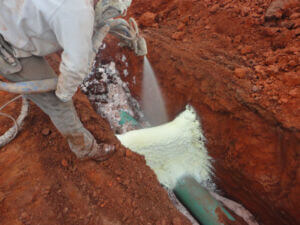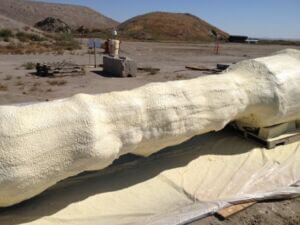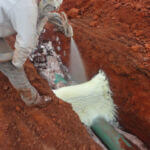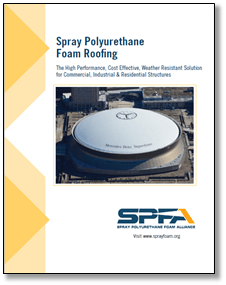Commercial
 The construction and SPF industries are mutual stakeholders in the other's success and growth. It is imperative that professional construction trades be very familiar with SPF, its health & safety considerations, and the impact quality of installation has on performance.
The construction and SPF industries are mutual stakeholders in the other's success and growth. It is imperative that professional construction trades be very familiar with SPF, its health & safety considerations, and the impact quality of installation has on performance.
A knowledgeable and informed construction professional, empowered by accurate consensus-developed information, can engage in meaningful dialog with SPF professionals and dramatically increase the likelihood of project success and customer satisfaction.
If you are a home builder, commercial builder, architect, general contractor, building code official, or otherwise considered a “professional customer” in the construction industry, the following resources are intended to aid you in your selection, specification, use, and proper understanding of SPF.
Spray polyurethane foam (SPF) roofing is a widely utilized roofing solution proven to last and protect the structure. SPF roofing performs as an insulated roofing system that withstands extreme weather conditions such as hail, wind and rain. Yet the installed weight per square foot allows building owners, consultants and designers many more possibilities than heavier roofing systems.
Most SPF roofing systems offer Class A fire performance. With durable, versatile SPF roofing, enjoy a roof lifespan exceeding 20 years with regular care and maintenance. Regular inspection and recoating can extend the service life to as long as 40 years or more.
SPF Roofing Video Series
The SPFA Roofing Committee recently developed five short videos about SPF roofing topics including Installation Basics, Energy Efficiency, Durability, Maintainability and Design Considerations.
Click on the icons below to view each video.
Coming in later in 2025...
Design Considerations
Successful Roof Solutions
SPF roofing provides a seamless, continuous layer over the top of the structure. The roof system performs numerous functions: vapor retarder, weather-resistant barrier, air barrier and continuous thermal insulation. SPF forms a durable and rigid covering that provides resistance to impact from hail and foot traffic. Read more about the benefits of SPF Roofs in our Roofing Brochure.
Cost-Effective Roofing Solutions
Learn how SPF roofing systems are cost-competitive with other low-slope roofing systems. In 2004, Michaelson Technologies, LLC developed a life-cycle cost analysis of SPF and competitive membrane roofing systems in the report below.
2004 Roofing Life Cycle Cost Analysis, Michaelson Technologies (2004)
This report was updated in 2020 by Mr. Mason Knowles and published in Spray Foam Magazine
Commercial Insulation
Spray foam insulation has been used to achieve energy efficiency and performance goals for a wide range of commercial and industrial buildings. As a high-performance foam plastic insulation, spray polyurethane foam is formulated to meet building codes and other performance requirements of the commercial building enclosure.
Medium-density (2 lb) closed-cell spray foam insulation is suitable for use in both exterior and interior surface applications while low-density (1/2 lb) open-cell spray foam insulation products are best suited for interior surface applications. Both classes of spray foam insulation can be used in several building types, including institutional, educational, healthcare, retail, commercial and military among others.

Metal Buildings

Agricultural/Industrial

Masonry Construction

Commercial Buildings
Air Barrier Systems
Control of air movement through the building enclosure is key to controlling heat, moisture an indoor air quality. Unwanted air leakage is controlled by an air barrier system - a continuous air-impermeable control layer srrounding the entire building enclosure.
Air barriers are necessary to meet current energy efficiency codes. For residential buildings, a whole-house air leakage is typically required (ASTM E779), with limits on allowable air leakage based on climate zone. For commercial buildings where whole-building air leakage measurements may not be practical, an air barrier is prescribed by the energy codes.
According to the Air Barrier Association of America (ABAA), air barriers consist of:
- Air Barrier Materials - materials with an air permeability not to exceed 0.004 cfm/ft2 under a pressure differential of 0.3 in. water (1.57psf) (0.02 L/s.m2 @ 75 Pa) when tested in accordance with ASTM E 2178.
- Air Barrier Assemblies - A building assembly of air barrier materials and air barrier accessories (e.g., tapes and sealants) with an air permeance not to exceed 0.04 cfm/ft2 under a pressure differential of 0.3 in. water (1.57psf) (0.2 L/s.m2 @ 75 Pa) when tested in accordance with ASTM E 2357.
- Air Barrier System - A building enclosure where the air leakage of the entire building shall not exceed 0.4 cfm/ft2 under a pressure differential of 0.3 in. water (1.57psf) (2.0 L/s.m2 @ 75 Pa) when tested according to ASTM E 779
Air barriers come in several forms, including:
- Mechanically-attached membranes, also known as housewraps, usually a polyethylene-fiber or spun-bonded polyolefin, such as Tyvek is a generally accepted moisture barrier and an air barrier (ASTM E2178).
- Self-adhered membranes, which are typically also a water-resistant barrier and a vapor barrier
- Fluid-applied membranes, such as heavy-bodied paints or coatings including polymeric based and asphaltic based materials
- Closed-cell medium density spray-applied polyurethane foam, which typically provides insulation as well
- Some open-cell spray-applied polyurethane foam that are of high density
- Boardstock, which includes 12 mm plywood or OSB, 25 mm extruded polystyrene, etc.
SPF insulations meet the air barrier material requirements at typically-installed thicknesses of 3.5-5.5 inches for open-cell and 1.0 inches for closed-cell. This data is typically posted by SPF manufacturers in technical data sheets or code-compliance reports. Many SPF products have been tested and meet the assembly air leakage requirements. An NAHB study measuring air leakage for 56 homes using SPF insulation consistently yeild whole-house air leakage values of less than 1.5 ACH50.
Geotechnical Applications
Below are just a few examples of how SPF can be used for non-insulation applications.
Concrete Lifting and Stabilization
- Expanding structural foam Leveling – 5/8” dia. holes drilled into slab and liquid polyurethane foam is injected and expands to raise and level slab.
- Smaller holes, clean installation and resistance to future erosion make SPF a superior solution.
Watch this video showing how SPF can be injected beneath a damaged concrete sidewalk to eliminate a dangerous trip hazard.
(video courtesy of Elite Concrete Lifters (VA)
Soil Stabilization
Methods of Soil Stabilization:
- Compaction – tamping and compression for predominantly horizontal surfaces
- Additives – binders including cements and other inorganic reactive materials, as well as organic adhesives mixed into soil; useful where mixing is possible
- Trenching – Use of temporary walls for narrow trenches
- Mechanical – Use of netting and coverings
SPF provides superior mechanical soil stabilization over a wide range of materials, slopes and geometries.

Underground Pipeline Construction
- Stabilize piping until backfill is complete
- Dramatically reduces rainwater erosion during construction
- SPF – provides support pads and trench blocks and can be used to cover and protect pipe from rock damage during backfill

Marine Flotation
- Closed-cell SPF formulated to meet USCG floatation requirements
- Durable flotation for vessels, pontoons and buoys
- Application below applied SPF to interior surface of 40ft long marine buoy

Humane Animal Exclusion
- A colony of a protected species of bat needed to be humanely relocated to prolong the service life of highway bridges.
- SPF installed in between deck gaps above pier cap and wing wall of several bridges

Waste Encapsulation
- An SPF formulation has been developed to inject inside and spray onto radioactive equipment
- High-density (6 lb/ft3) SPF with high compressive strength has been developed for this application
- SPF may be covered with a polyurea coating to provide additional water resistance needed for burial

















